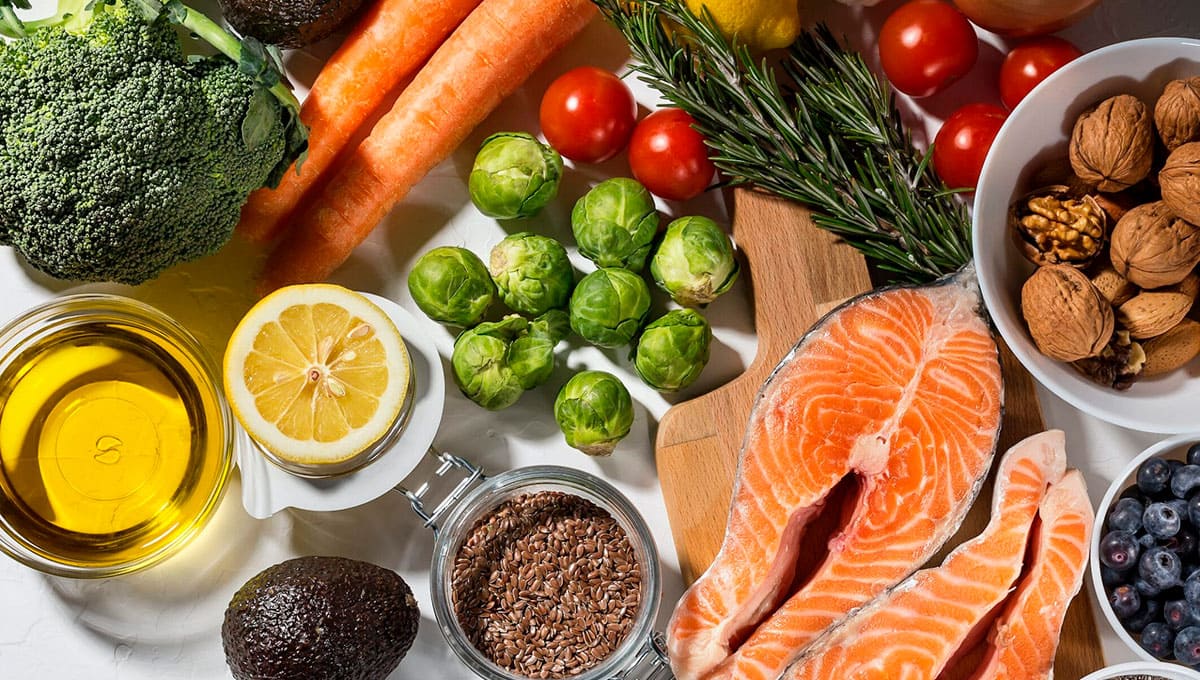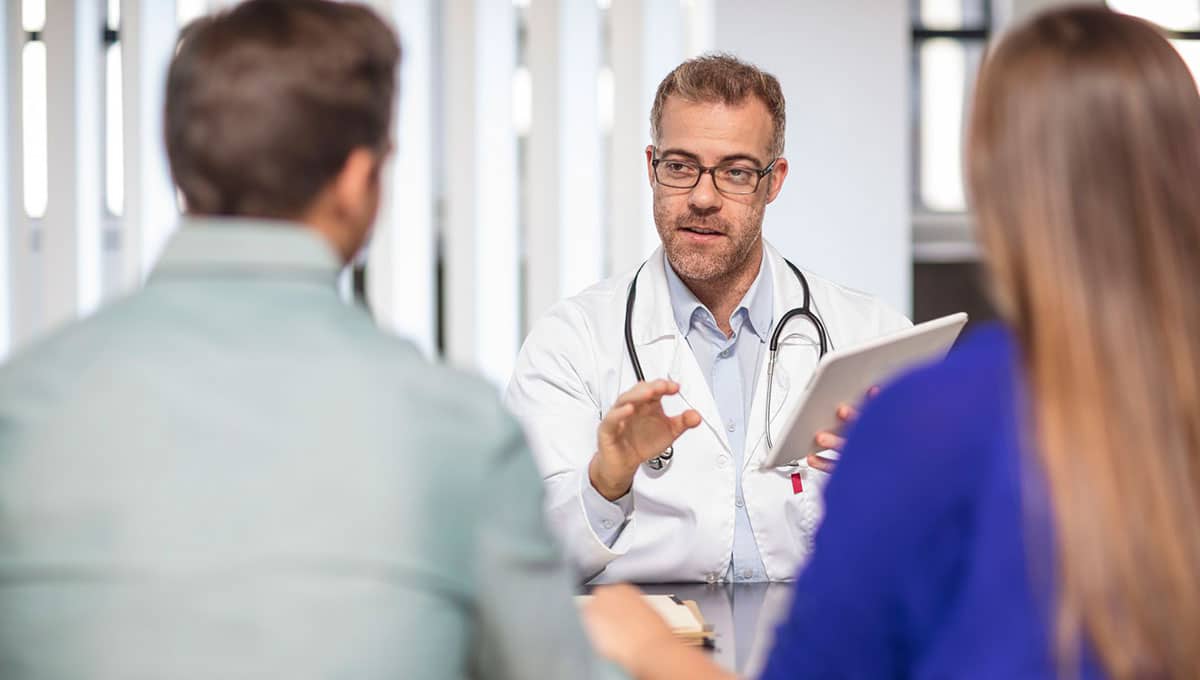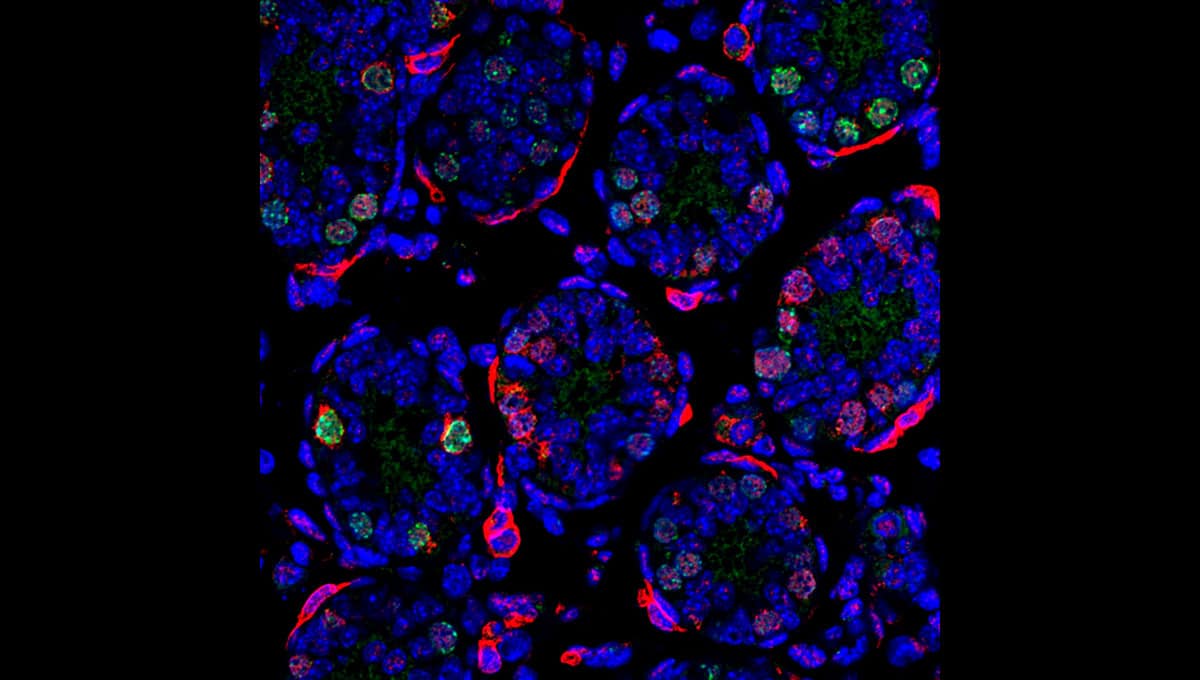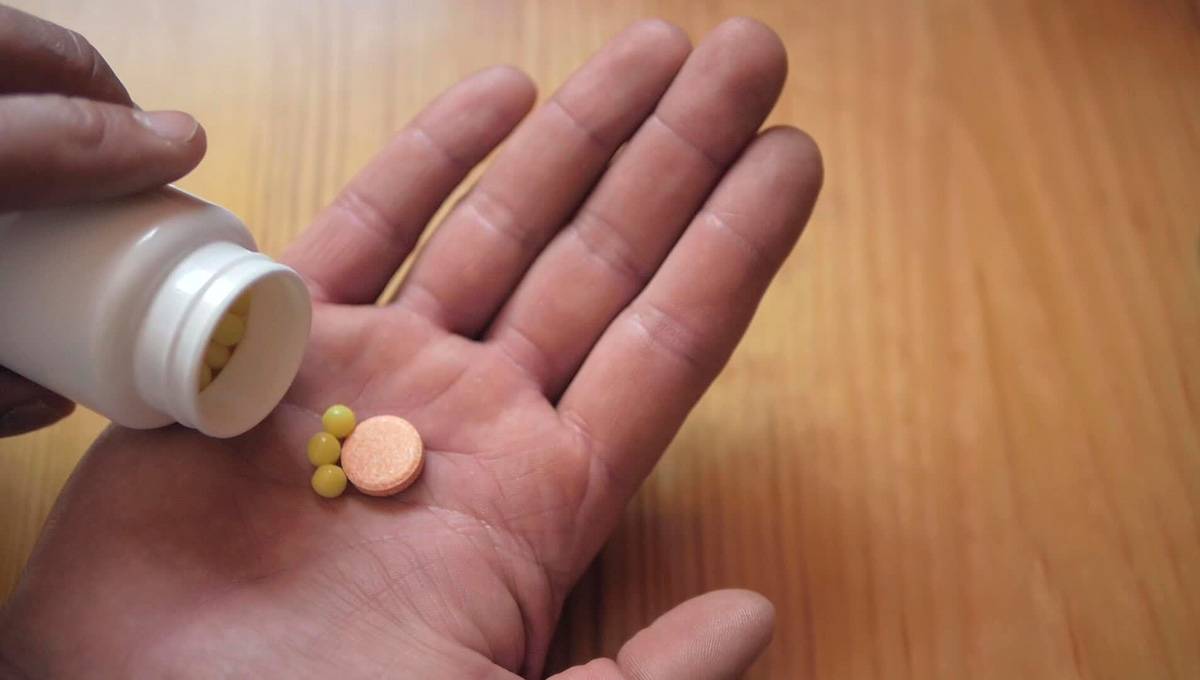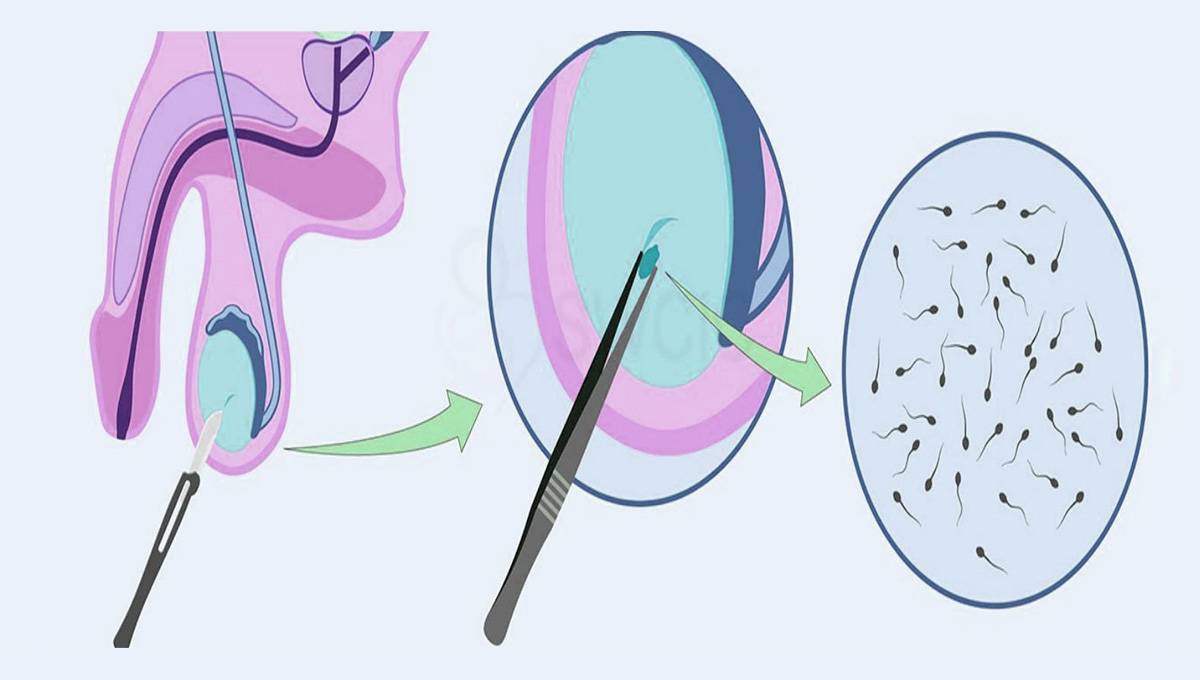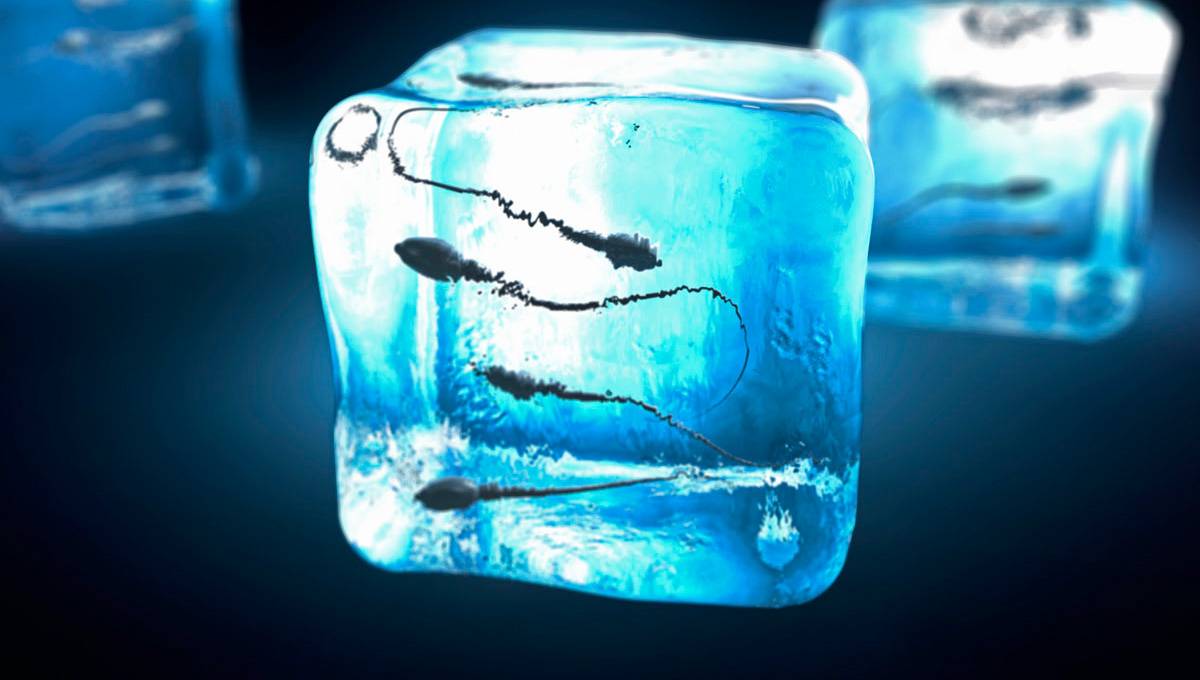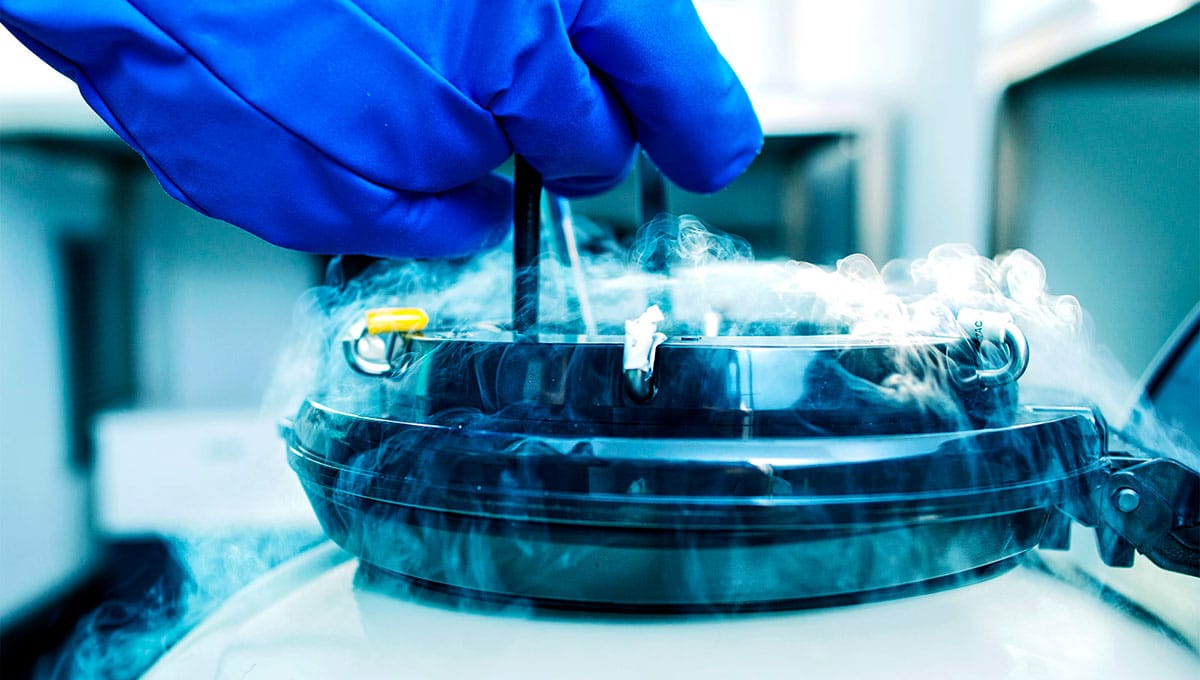What is sperm morphology?
Sperm morphology is a term which describes the appearance of sperm cells under a microscope. The important factors which doctors examine are the shape and size of the sperm cells.
What is normal for sperm cells?
Sperm cells have a distinctive shape. They each have an oval-shaped head and a long tail which allows them to swim.
The sperm head is approximately 5 – 6 micrometres long and 2.5 – 3.5 micrometres wide. The midpiece of the sperm connects the head to the tail, and it is the same length as the head but slimmer. The tail is the longest part of the sperm cell, at 45 micrometres long. Sperm cells are tiny compared to egg cells, which are around 30 times larger.
There can be many variations in the appearance of sperm cells which can affect their head, midpiece or tail. These differences include multiple tails and misshapen sperm heads.
The shape of the head of the sperm cell is important because this is the part of the sperm which comes into contact with an egg cell. During fertilisation, the head of the sperm cell dissolves the outer layer of the egg cell using enzymes. Therefore the shape of the sperm cell head can directly affect whether fertilisation is successful.

www.amitamin.com/en/fertilsan-m New life deserves the best possible start!We provide the essential building blocks for this.
What do sperm morphology results mean?
Sperm morphology results are given as a percentage of sperm which have a normal appearance, or normal form (NF). These values can vary according to the lab. The most commonly used range is that 4 – 14% of a man”s sperm cells should have a normal appearance.
The amount of healthy sperm cells required to have a good fertility level is not very high at only 4%. This normal value has reduced over the last few decades due to a number of reasons including environmental factors 1 Menkveld R. Clinical significance of the low normal sperm morphology value as proposed in the fifth edition of the WHO Laboratory Manual for the Examination and Processing of Human Semen. Asian Journal of Andrology. 2010. 12(1):47-58.
Every man has some abnormal sperm cells. But having a higher percentage of sperm with normal morphology increases the chances of you being able to successfully conceive with your partner faster.
What if my morphology result is low and most or all of my sperm cells are abnormal?
Teratospermia or teratozoospermia is the medical name for having a high proportion of sperm cells with an abnormal appearance which affects your fertility. Men with less than 4% of sperm cells with a normal appearance may take longer to conceive with their partners.
However abnormal sperm cells can still fertilise egg cells. This is because in many cases the genetic material inside the sperm cells is unaffected, despite the abnormal appearance of the cells. A recent study in 2017 found that men with no morphologically normal sperm cells were still able to conceive 2 Kovac JR, Smith RP, Cajipe M, Lamb DJ, Lipshultz LI. Men with a complete absence of normal sperm morphology exhibit high rates of success without assisted reproduction. Asian Journal of Andrology. 2017. 19(1):39-42.
Additionally scientists have developed techniques which can help men with a large proportion of abnormal sperm to conceive successfully. One option is Intracytoplasmic Sperm Injection (ICSI), which involves selecting good quality sperm cells to inject directly into the egg cell. Find out more about artificial fertilisation here.
There are also many ways you can improve your sperm morphology. By eliminating certain harmful lifestyle factors and including fertility boosting nutrients in your diet, you can improve your morphology result and your chances of conceiving naturally and faster. Find out how you can improve your sperm morphology below.
It is also important to remember that sperm morphology is just one part of a semen analysis, or seminogram. A semen analysis investigates a number of factors associated with male fertility and it gives a comprehensive insight into how a healthy a man”s sperm cells are. These factors need to be examined together to gain an accurate understanding of your fertility. The other important results from a semen analysis include sperm count and motility, or movement.
How can I improve my sperm morphology?
There are many things you can do to improve your sperm morphology. The following tips also help to improve other indicators of sperm health such as sperm count and concentration. As an added bonus, these tips will improve not just your fertility but your general health too.
1. Sperm cells are not party animals
Regularly consuming alcohol in excess can reduce testosterone levels in men 3 Emanuele MA, Emanuele NV. Alcohol”s effects on male reproduction. Alcohol Health and Research World. 1998. 22(3):195-201. This in turn affects sperm cell development.
High levels of alcohol intake can have a negative effect on sperm morphology, as well as many other indicators of sperm health including sperm concentration, sperm count and motility. The effects are worse the higher the amount of alcohol you regularly consume 4 Jensen TK, Gottschau M, Madsen JOB, Andersson AM, Lassen TH, Skakkebaek NE, Swan SH, Priskorn L, Juul A, Jorgensen N. Habitual alcohol consumption associated with reduced semen quality and changes in reproductive hormones; a cross- sectional study among 1221 young Danish men. BMJ Open. 2014. 4(9). Furthermore alcohol can affect other aspects of male fertility including libido and it can cause impotence in some cases.
Therefore it is important to reduce your alcohol intake. You do not have to become teetotal, but you should keep your alcohol consumption within safe limits. The official guidelines recommend drinking no more than 14 units of alcohol per week on a regular basis.
This is equal to six pints of average strength (4%) beer. Additionally it is best to spread out the amount you drink per week over three or more days. This is because binge drinking is particularly harmful.
2. Smoking shuts down sperm cells
It is a well- known fact that smoking is bad for your health. Scientists have now discovered exactly how it can affect your sperm cells.
Smoking has a harmful impact on a range of indicators of sperm health. These include sperm morphology, count and motility 5 Sharma R, Harlev A, Agarwal A, Esteves SC. Cigarette smoking and semen quality: a new meta-analysis examining the effect of the 2010 World Health Organisation laboratory methods for the examination of human semen. European Urology. 2016. 70(4):635-645. Smoking can also result in erectile dysfunction due to the damage it causes to blood vessels. Furthermore the more you smoke, the worse the damage is 6 Pourmand G, Alidaee MR, Rasuli S, Maleki A, Mehrsai A. Do cigarette smokers with erectile dysfunction benefit from stopping?: a prospective study. BJU International. 2004. 94(9):1310-1313.
The good news is that your body starts to recover and works on reversing the damage as soon as you stop smoking. Therefore in order to maximise your chances of conceiving, you should stop smoking as soon as possible.
The reasons to stop smoking go far beyond successfully conceiving with your partner, and they affect your journey into parenthood and beyond. This is because smoking not only harms your body, but also those around you as you are exposing them to second- hand smoke. If you smoke and your partner does not, this can still affect the developing baby.
Second-hand smoke can result in the baby having a lower birth weight 7 Norsa”adah B, Salinah O. The effect of second-hand smoke exposure during pregnancy on the newborn weight in Malaysia. Malaysian Journal of Medical Sciences. 2014. 21(2):44-53. This can cause a range of problems for the baby including infections and breathing difficulties.
Furthermore if you and your partner undergo fertility treatments such as IVF, exposing your partner to second-hand smoke can reduce the chances of these treatments being successful 8 Neal MS, Hughes EG, Holloway AC, Foster WG. Sidestream smoking is equally as damaging as mainstream smoking on IVF outcomes. Human Reproduction. 2005. 20(9):2531-5. The effects of second-hand smoke are also worse in babies and young children and it can cause cot death.
Quitting smoking is difficult but there are many sources of support. There is advice available on the NHS website to help you to quit here 9 NHS. Smokefree. 2018. You can also speak to your GP for more information.
3. Sperm cells like to chill
The optimal temperature for sperm production is slightly cooler than that of the rest of the body. This is why testicles are located outside the body. Because of this, the testicles can have a temperature 2 – 3°C lower than the core body temperature.
High temperatures can damage sperm morphology, creating more cells with an abnormal appearance 10 Dada R, Gupta NP, Kucheria K. Deterioration of sperm morphology in men exposed to high temperature. Journal of the Anatomical Society of India. 2001. 50(2):107-111. Therefore it is important to keep your scrotal temperature cool.
Tight clothing can increase scrotal temperature, in particular wearing tight underwear. Therefore it is best to wear loose fitting boxer shorts instead of briefs.
It is also better for your sperm if you choose showers instead of hot baths, and avoid using saunas regularly. Additionally try to avoid regularly resting your laptop on your lap, as this can generate a surprising amount of heat.
4. Keep an eye on the scales
Male obesity levels have soared in recent years, and this is associated with a rise in couples needing fertility treatments 11 Palmer NO, Bakos HW, Fullston T, Lane M. Impact of obesity on male fertility, sperm function and molecular composition. Spermatogenesis. 2012. 2(4):253-263. Obesity reduces testosterone levels, which affects spermatogenesis. This is the process during which the body produces sperm cells. As a result, obesity has a harmful impact on sperm morphology, concentration and sperm count 12 Katib A. Mechanisms linking obesity to male infertility. Central European Journal of Urology. 2015. 68(1):79-85.
Furthermore the higher a man”s BMI is, the worse the effects are on his fertility 13 Nguyen RH, Wilcox AJ, Skjaerven R, Baird DD. Men”s body mass index and infertility. Human Reproduction. 2007. 22(9):2488-2493. Therefore monitoring your weight and losing any excess weight is extremely important when trying to conceive. The good news is that by losing weight, you can reverse the damage done to your fertility and improve the health of your sperm cells 14 Hakonsen LB, Thulstrup AM, Aggerholm AS, Olsen J, Bonde JP, Andersen CY, Bungum M, Ernst EH, Hansen ML, Ernst EH, Ramlau-Hansen CH. Does weight loss improve semen quality and reproductive hormones? Results from a cohort of severely obese men. Reproductive Health. 2011. 8:24.
The best ways to lose weight are eating a healthy, balanced diet and exercising regularly. You can find resources to help you lose weight on the NHS website here 15 NHS. Healthy Weight. 2018..
5. Fuel your sperm cells
There is evidence showing that the following nutrients can improve sperm morphology. Therefore you should aim to include these as part of a balanced diet. Alternatively these nutrients are also available as dietary supplements, either individually or in combinations tailored to improve fertility. Click on each nutrient below to find out more.
Vitamin B12, also known as cobalamin, is a key part of many reactions in the body related to metabolism. It also helps to improve sperm morphology 16 Banihani SA. Vitamin B12 and semen quality. Biomolecules. 2017. 7(2):42. Vitamin B12 is present in many foods including:
• Meat
• Fish
• Eggs
• Dairy products
• Fortified cereals
Vitamin C
Vitamin C is an antioxidant. It can also boost your sperm count as well as improving sperm morphology 17 Akmal M, Qadri JQ, Al-Waili NS, Thangal S, Haq A, Saloom KY. Improvement in human semen quality after oral supplementation of vitamin C. Journal of Medicinal Food. 2006. 9(3):440-442. Good dietary sources of vitamin C include:
• Citrus fruits
• Other fruits including strawberries and kiwis
• Vegetables including broccoli, cabbage and cauliflower
• Peppers
• Sweet and white potatoes
• Fortified cereals
Omega-3 fatty acids
Omega-3 fatty acids have a huge variety of benefits and they are commonly used to support a healthy heart. They can also boost many indicators of sperm health including morphology, count and motility 18 Safarinejad MR, Safarinejad S. The roles of omega-3 and omega-6 fatty acids in idiopathic male infertility. Asian Journal of Andrology. 2012. 14(4):514-515. Good sources of omega-3 fatty acids are:
• Fish and seafood including tuna, salmon and mackerel
• Seeds and nuts including walnuts and flaxseed
• Plant- based oils including soybean and canola oil
Arginine
Arginine is an amino acid which changes into nitric oxide inside the body. Nitric oxide is a molecule which is known for being a vasodilator, which means it can widen blood vessels in the body and improve blood flow. Nitric oxide is also important for sperm function.
Scientists have previously found that arginine can improve sperm morphology in animal studies 19 Husein RH, Ahmed MO, Muhammed SM. Effects of L-arginine, vitamin E and their combinations on sperm morphology in albino male mice. Journal of Al-Nahrain University. 2011. 14(2):137-143. More recently, research has shown that arginine can improve sperm morphology in men 20 Stanislavov R, Rohdewald P. Sperm quality in men is improved by supplementation with a combination of L-arginine, L-citrullin, roburins and Pycnogenol. Italian Journal of Urology and Nephrology. 2014. 66(4):217-223, and it may also have a positive effect on sperm motility 21 Scibona M, Meschini P, Capparelli S, Pecori C, Rossi P, Menchini Fabris GF. L-arginine and male infertility. Italian Journal of Urology and Nephrology. 1994. 46(4):251-253. Good sources of arginine include:
• Meats including chicken and turkey
• Seeds including pumpkin and sesame seeds
• Soybeans
• Nuts including peanuts, cashews and almonds
• Dairy products including milk, cheese and yoghurt
• Chickpeas and lentils
Carnitine
The body produces carnitine in the liver and kidneys from amino acids. It has a particularly important role in energy production in the body. Scientists have also found that it can improve both sperm morphology and motility 22 Ahmadi S, Bashiri R, Ghadiri-Anari A, Nadjarzadeh A. Antioxidant supplements and semen parameters: an evidence based review. International Journal of Reproductive Biomedicine. 2016. 14(12):729-736. Dietary sources of carnitine include:
• Meat, especially red meat
• Fish
• Dairy products
Glutathione
Glutathione is a vital antioxidant which is made from the amino acids cysteine, glycine and glutamine. Glutathione is produced by the liver, and it is present in all of the cells of the body. Therefore it is no surprise that it has a role in improving sperm morphology 23 Lenzi A, Lombardo F, Gandini L, Culasso F. Dondero F. Glutathione therapy for male infertility. Archives of Andrology. 1992. 29(1):65-68.
Certain factors such as ageing and stress can reduce the amount of glutathione in the body. Therefore it is important to boost your glutathione levels, and there are many foods which can help you do this.
Some of the following dietary recommendations boost glutathione levels directly, and some support them indirectly by increasing the levels of compounds such as sulfur which are needed to produce glutathione. The important foods to include are:
• Meats including beef, chicken and fish
• Vegetables including spinach, onions, asparagus, broccoli, sprouts and kale
• Garlic
• Fruits including citrus fruits and avocados
Coenzyme Q10
Coenzyme Q10 is an antioxidant which is naturally present in the human body. It has important roles in energy production and growth, and it can be beneficial in improving cardiac health and reducing blood pressure.
Scientists have also found that it can be useful for various indicators of sperm health, in particular sperm morphology 24 Safarinejad MR, Safarinejad S, Shafiei N, Safarinejad S. Effects of the reduced form of coenzyme Q10 (ubiquinol) on semen parameters in men with idiopathic infertility: a double-blind, placebo controlled randomized study. Journal of Urology. 2012. 188(2):526-531 and motility 25 Lafuente R, Gonzalez-Comadran M, Sola I, Lopez G, Brassesco M, Carreras R, Checa MA. Coenzyme Q10 and male infertility: a meta-analysis. Journal of Assisted Reproduction and Genetics. 2013. 30(9):1147-1156. Good dietary sources of coenzyme Q10 include:
• Meats including beef and pork
• Organ meats such as kidney and liver
• Fish including mackerel and tuna
• Vegetables such as cauliflower and spinach
• Fruits
Pycnogenol
Pycnogenol is also known as the extract of French maritime pine bark. It has antioxidant effects and it may be useful in a range of health problems including asthma and Attention Deficit Hyperactivity Disorder (ADHD). Scientists have also found that it can improve both sperm morphology and sperm function 26 Roseff SJ. Improvement in sperm quality and function with French maritime pine tree bark extract. Journal of Reproductive Medicine. 2002. 47(10):821-824.
The best way to increase your pycnogenol intake is in the form of dietary supplements, which are widely available. The active ingredients in pycnogenol are also present in other substances including witch hazel bark, peanut skin and grape seed.
Zinc
Zinc is a trace element, and it is crucial in supporting a healthy immune system. It can also improve many aspects of sperm health including sperm morphology, motility and semen volume 27 Zhao J, Dong X, Hu X, Long Z, Wang L, Liu Q, Sun B, Wang Q, Wu Q, Li L. Zinc levels in seminal plasma and their correlation with male infertility: A systematic review and meta-analysis. Scientific Reports. 2016. 6. Good dietary sources of zinc include:
• Shellfish
• Meats, especially red meats and beef
• Nuts and seeds
• Whole grains
• Chickpeas, beans and lentils
Selenium
Selenium is a trace element which is important in preventing cell damage. Scientists have also found that it can help to improve sperm morphology and motility 28 Moslemi MK, Tavanbakhsh S. Selenium-vitamin E supplementation in infertile men: effects on semen parameters and pregnancy rate. International Journal of General Medicine. 2011. 4:99-104. Dietary sources of selenium include:
• Whole grains
• Dairy products including yoghurt and milk
• Brazil nuts
• Meats including pork, turkey and beef
• Seafood including tuna and oysters
6. Stressed sperm cells are not happy
Planning to have a baby can be a very stressful time for couples, especially if you need to consider fertility treatments. However scientists have found that stress can damage your sperm by having a negative impact on sperm morphology and concentration 29 Janevic T, Kahn LG, Landsbergis P, Cirillo PM, Cohn BA, Liu X, Factor-Litvak P. Effects of work and life stress on semen quality. Fertility and Sterility. 2014. 102(2):530-538.
It is important to discuss how you feel with your partner, as this is a journey you are taking together and they probably feel the same way as you. Try to open up to trusted friends and family members about your worries so that they can better support you during this stressful time.
The journey to parenthood can be long, and it important to maintain balance in your life by focussing on other activities too. Hobbies such as exercise can be a good distraction, and it will help to release endorphins which will boost your mood.
It is also crucial that you are getting enough sleep, as sleep deprivation can worsen stress levels 30 Meerlo P, Sgoifo A, Suchecki D. Restricted and disrupted sleep: effects on autonomic function, neuroendocrine stress systems and stress responsivity. Sleep Medicine Reviews. 2008. 12(3):197-210. Testosterone production is at its highest when sleeping. Therefore the less sleep you get, the less testosterone your body produces 31 Leproult R, Cauter EV. Effect of one week of sleep restriction on testosterone levels in young healthy men. Journal of the American Medical Association. 2011. 305(21):2173-2174.
You should ideally aim for 7-9 hours of sleep per night. Try to avoid having naps during the day and drinks containing caffeine in the evening. It is also a good idea to build a routine of going to bed and waking at the same time, as this will help you sleep better.
7. Help both your sperm and the environment
Pollution has many damaging effects on health especially on respiratory conditions. But surprisingly it can also affect sperm cells. Research has shown that air pollution may affect sperm morphology, as well as sperm count and concentration 32 Hansen C, Luben TJ, Sacks JD, Olshan A, Jeffay S, Strader L, Perreault SD. The effect of ambient air pollution on sperm quality. Environmental Health Perspectives. 2010. 118(2):203-209.
If you live in a bustling city, exposure to pollution might feel inevitable. But there are some small steps you can take to help protect yourself and the environment too.
In the UK, the government releases daily air pollution forecasts online 33 Department for Environmental Food and Rural Affairs. UK Air. Air Information Resource. 2018. You can find these here, and you can also receive daily updates on your mobile. On days when the pollution level is particularly high, it is best to avoid exercising outdoors.
It is also good to minimise the use of your car and walk whenever possible. This is because inside a car, pollutants can accumulate. By walking, you can avoid busier streets and use quieter side streets where there is less pollution.
If you need to use a car, car share or use public transport as much as you can. When you drive, remember to avoid leaving the engine running when the car is stationary. Also try to minimise the number of journeys you make by planning ahead. This will help both your sperm and your wallet.
There are also ways you can protect yourself from pollution at home. Try to minimise your use of fireplaces or wood stoves, and avoiding burning leaves or other rubbish. It is also a good idea to generally keep your house well ventilated, especially in the kitchen when cooking.
8. Stop the clock
In general, sperm cells tend to be healthier the younger you are. As sperm health decreases with age 34 Harris ID, Fronczak C, Roth L, Meacham RB. Fertility and the aging male. Reviews in Urology. 2011. 13(4):184-190, you may want to consider freezing your sperm until you are ready to use them. Find out more here.

Dr. Jones is an experienced consultant in assisted reproduction.
He has worked as a Fertility specialist at Kingston Hospital Assisted Conception and nearly 10 years experience of working in Obstetrics and Gynaecology across hospitals in the UK.
He completed his Masters in Assisted Reproduction Technology and then his PhD, from Imperial College London. Dr. Jones main areas of interest are Single Embryo Transfer, Endometriosis, PCOS and Implantation failure in IVF patients. He is a member of the British Fertility Society and an associate member of the Royal College of Obstetrics and Gynaecology.
Bibliography
- 1Menkveld R. Clinical significance of the low normal sperm morphology value as proposed in the fifth edition of the WHO Laboratory Manual for the Examination and Processing of Human Semen. Asian Journal of Andrology. 2010. 12(1):47-58
- 2Kovac JR, Smith RP, Cajipe M, Lamb DJ, Lipshultz LI. Men with a complete absence of normal sperm morphology exhibit high rates of success without assisted reproduction. Asian Journal of Andrology. 2017. 19(1):39-42
- 3Emanuele MA, Emanuele NV. Alcohol”s effects on male reproduction. Alcohol Health and Research World. 1998. 22(3):195-201
- 4Jensen TK, Gottschau M, Madsen JOB, Andersson AM, Lassen TH, Skakkebaek NE, Swan SH, Priskorn L, Juul A, Jorgensen N. Habitual alcohol consumption associated with reduced semen quality and changes in reproductive hormones; a cross- sectional study among 1221 young Danish men. BMJ Open. 2014. 4(9)
- 5Sharma R, Harlev A, Agarwal A, Esteves SC. Cigarette smoking and semen quality: a new meta-analysis examining the effect of the 2010 World Health Organisation laboratory methods for the examination of human semen. European Urology. 2016. 70(4):635-645
- 6Pourmand G, Alidaee MR, Rasuli S, Maleki A, Mehrsai A. Do cigarette smokers with erectile dysfunction benefit from stopping?: a prospective study. BJU International. 2004. 94(9):1310-1313
- 7Norsa”adah B, Salinah O. The effect of second-hand smoke exposure during pregnancy on the newborn weight in Malaysia. Malaysian Journal of Medical Sciences. 2014. 21(2):44-53
- 8Neal MS, Hughes EG, Holloway AC, Foster WG. Sidestream smoking is equally as damaging as mainstream smoking on IVF outcomes. Human Reproduction. 2005. 20(9):2531-5
- 9NHS. Smokefree. 2018
- 10Dada R, Gupta NP, Kucheria K. Deterioration of sperm morphology in men exposed to high temperature. Journal of the Anatomical Society of India. 2001. 50(2):107-111
- 11Palmer NO, Bakos HW, Fullston T, Lane M. Impact of obesity on male fertility, sperm function and molecular composition. Spermatogenesis. 2012. 2(4):253-263
- 12Katib A. Mechanisms linking obesity to male infertility. Central European Journal of Urology. 2015. 68(1):79-85
- 13Nguyen RH, Wilcox AJ, Skjaerven R, Baird DD. Men”s body mass index and infertility. Human Reproduction. 2007. 22(9):2488-2493
- 14Hakonsen LB, Thulstrup AM, Aggerholm AS, Olsen J, Bonde JP, Andersen CY, Bungum M, Ernst EH, Hansen ML, Ernst EH, Ramlau-Hansen CH. Does weight loss improve semen quality and reproductive hormones? Results from a cohort of severely obese men. Reproductive Health. 2011. 8:24
- 15NHS. Healthy Weight. 2018.
- 16Banihani SA. Vitamin B12 and semen quality. Biomolecules. 2017. 7(2):42
- 17Akmal M, Qadri JQ, Al-Waili NS, Thangal S, Haq A, Saloom KY. Improvement in human semen quality after oral supplementation of vitamin C. Journal of Medicinal Food. 2006. 9(3):440-442
- 18Safarinejad MR, Safarinejad S. The roles of omega-3 and omega-6 fatty acids in idiopathic male infertility. Asian Journal of Andrology. 2012. 14(4):514-515
- 19Husein RH, Ahmed MO, Muhammed SM. Effects of L-arginine, vitamin E and their combinations on sperm morphology in albino male mice. Journal of Al-Nahrain University. 2011. 14(2):137-143
- 20Stanislavov R, Rohdewald P. Sperm quality in men is improved by supplementation with a combination of L-arginine, L-citrullin, roburins and Pycnogenol. Italian Journal of Urology and Nephrology. 2014. 66(4):217-223
- 21Scibona M, Meschini P, Capparelli S, Pecori C, Rossi P, Menchini Fabris GF. L-arginine and male infertility. Italian Journal of Urology and Nephrology. 1994. 46(4):251-253
- 22Ahmadi S, Bashiri R, Ghadiri-Anari A, Nadjarzadeh A. Antioxidant supplements and semen parameters: an evidence based review. International Journal of Reproductive Biomedicine. 2016. 14(12):729-736
- 23Lenzi A, Lombardo F, Gandini L, Culasso F. Dondero F. Glutathione therapy for male infertility. Archives of Andrology. 1992. 29(1):65-68
- 24Safarinejad MR, Safarinejad S, Shafiei N, Safarinejad S. Effects of the reduced form of coenzyme Q10 (ubiquinol) on semen parameters in men with idiopathic infertility: a double-blind, placebo controlled randomized study. Journal of Urology. 2012. 188(2):526-531
- 25Lafuente R, Gonzalez-Comadran M, Sola I, Lopez G, Brassesco M, Carreras R, Checa MA. Coenzyme Q10 and male infertility: a meta-analysis. Journal of Assisted Reproduction and Genetics. 2013. 30(9):1147-1156
- 26Roseff SJ. Improvement in sperm quality and function with French maritime pine tree bark extract. Journal of Reproductive Medicine. 2002. 47(10):821-824
- 27Zhao J, Dong X, Hu X, Long Z, Wang L, Liu Q, Sun B, Wang Q, Wu Q, Li L. Zinc levels in seminal plasma and their correlation with male infertility: A systematic review and meta-analysis. Scientific Reports. 2016. 6
- 28Moslemi MK, Tavanbakhsh S. Selenium-vitamin E supplementation in infertile men: effects on semen parameters and pregnancy rate. International Journal of General Medicine. 2011. 4:99-104
- 29Janevic T, Kahn LG, Landsbergis P, Cirillo PM, Cohn BA, Liu X, Factor-Litvak P. Effects of work and life stress on semen quality. Fertility and Sterility. 2014. 102(2):530-538
- 30Meerlo P, Sgoifo A, Suchecki D. Restricted and disrupted sleep: effects on autonomic function, neuroendocrine stress systems and stress responsivity. Sleep Medicine Reviews. 2008. 12(3):197-210
- 31Leproult R, Cauter EV. Effect of one week of sleep restriction on testosterone levels in young healthy men. Journal of the American Medical Association. 2011. 305(21):2173-2174
- 32Hansen C, Luben TJ, Sacks JD, Olshan A, Jeffay S, Strader L, Perreault SD. The effect of ambient air pollution on sperm quality. Environmental Health Perspectives. 2010. 118(2):203-209
- 33Department for Environmental Food and Rural Affairs. UK Air. Air Information Resource. 2018
- 34Harris ID, Fronczak C, Roth L, Meacham RB. Fertility and the aging male. Reviews in Urology. 2011. 13(4):184-190
